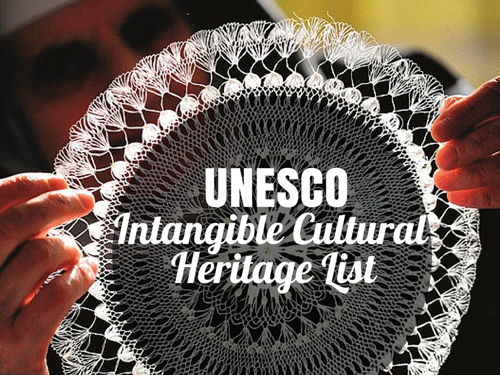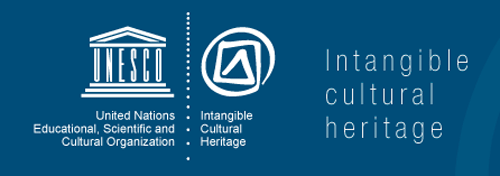Official labels and lists
- rosemarydearman1
- Apr 13, 2017
- 4 min read
"The importance of intangible cultural heritage is not the cultural manifestation itself but rather the wealth of knowledge and skills that is transmitted through it from one generation to the next." UNESCO

I have a list of potential topics sitting by my computer and the UNESCO Intangible Cultural Heritage List was one of them. I can't quite remember how I came across it - I think there might have been an item of news about Mexican cuisine being added to the list. Anyway it got me to wondering what else might be on the list and what was it all about anyway. And then today when I started on it I thought I might touch on other official approvals, labels and lists - of which there are doubtless many that I know nothing of. I think I might then have occasional posts on things on this list in particular and maybe others too.
So what is the UNESCO Intangible Cultural Heritage List? Their website has a full explanation but I will give you a few quotes from it here.
"Cultural heritage does not end at monuments and collections of objects. It also includes traditions or living expressions inherited from our ancestors and passed on to our descendants, such as oral traditions, performing arts, social practices, rituals, festive events, knowledge and practices concerning nature and the universe or the knowledge and skills to produce traditional crafts.
While fragile, intangible cultural heritage is an important factor in maintaining cultural diversity in the face of growing globalization."
"intangible cultural heritage is not merely valued as a cultural good, on a comparative basis, for its exclusivity or its exceptional value. It thrives on its basis in communities and depends on those whose knowledge of traditions, skills and customs are passed on to the rest of the community, from generation to generation, or to other communities."
The list is very long and includes a whole lot of things that have nothing to do with food, but even if you just extract the foody things there is still quite a lot of stuff on there. But what a weird collection. With respect to cuisines for example there only seems to be French, Mexican, and Japanese and the Mediterranean diet. Why not Chinese, or Italian, or Persian for example. And lavash making in Armenia? Well I will come to these things individually and ponder on their inclusion on upcoming posts, but in the meantime I think it might really be a bit of a waste of time and doubtless involves huge amounts of money, compiling the list. Presumably things get on the list because somebody lobbies for them. And the UNESCO explanation did indeed say, "intangible cultural heritage can only be heritage when it is recognized as such by the communities, groups or individuals that create, maintain and transmit it – without their recognition, nobody else can decide for them that a given expression or practice is their heritage." Which does indeed sound like UNESCO saying that it's up to the countries and people involved to nominate their particular tradition.
We had a bit of an argument at home today about political correctness, and this sort of falls into that category I think. Yes it's great to recognise a festival, a craft, a food, a custom as important to the world's cultural heritage, but I doubt it really changes anything unless it's aiming to increase cultural tourism. I mean we all know, for example, that French cuisine is one of the world's great cuisines and no doubt it brings pride to a Frenchman's heart to be officially recognised. But is this a good thing? Personally I think that national pride leads to nationalistic fervour and in a worst case scenario - war. It certainly doesn't lead to understanding and co-operation. It's more likely to encourage a feeling of superiority which is never a good thing. Pride is a difficult thing. Yes we should be proud when we achieve something, but it can prevent us admitting to faults, and it can lead to unhealthy competition and arrogance I think. Pride and Prejudice and all that.
I suppose there is an argument for recognising the lesser known things, like the Armenian lavash, but what difference is it going to make to the Armenians I have to ask?
There's a logo and everything which probably cost a fortune, and which I am probably not allowed to use - but here it is anyway. I have no idea of the thinking behind it. Go ponder on that. A triangle, within a square, within an open circle - well they are all open I guess.

And what about those other 'official' approvals and lists - things like the French Appelation Contrôlée and the European Union's various labels. Again I am a bit ambivalent about them. Here in Australia wine used to get labelled as claret and hermitage, which was a sort of roundabout way of saying bordeaux and burgundy, but that was stamped out - and look it's not a bad thing. Now we have beautiful wine labels, the wine is classified by the grapes that go into it - which is informative - and everyone is happy. Then there's all that battle over Parmesan as a name. And even the people who produce the products that are given these labels feel a bit restricted sometimes I would guess, because there are very strict rules about what you can put in your bottle of Burgundy or Bordeaux. If you don't have it just right you have lost the label.
I don't think that anything Australian is on the Intangible Cultural Heritage List. I wonder what you would put on it if you wanted to suggest something. Something uniquely Australian. Ideas anyone? I do not count the Aboriginals here of course, because they do indeed have cultural traditions that are unique to them and which go back for thousands of years. Which makes me wonder whether there should be a time factor on these things.
Anyway food for thought!
Watch this space for some of the foody things on the list - not necessarily what you would expect either.












Comments